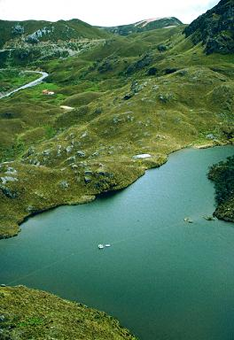NOAA/WDS Paleoclimatology - Fayetteville Green Lake Glacial-Holocene Stable Isotope Data
This archived Paleoclimatology Study is available from the NOAA National Centers for Environmental Information (NCEI), under the World Data Service (WDS) for Paleoclimatology. The associated NCEI study type is Lake. The data include parameters of paleolimnology with a geographic location of New York, United States Of America. The time period coverage is from 14561 to 3186 in calendar years before present (BP). See metadata information for parameter and study location details. Please cite this study when using the data.
Dataset Citation
- Cite as: Kirby, M.E.; Mullins, H.T.; Patterson, W.P.; Burnett, A.W. (2009-05-01): NOAA/WDS Paleoclimatology - Fayetteville Green Lake Glacial-Holocene Stable Isotope Data. [indicate subset used]. NOAA National Centers for Environmental Information. https://doi.org/10.25921/33nh-sh65. Accessed [date].
- Please refer to Credit tab for full citation information.
Dataset Identifiers
- doi:10.25921/33nh-sh65
- noaa-lake-8655
- NCEI DSI 1200_02
- NCEI DSI 1200_01
ISO 19115-2 Metadata
noaa-lake-8655
| Search Data |
|
| Download Data |
|
| Distribution Formats |
|
| Ordering Instructions | Contact NCEI for other distribution options and instructions. |
| Distributor |
NOAA National Centers for Environmental Information ncei.info@noaa.gov |
| Dataset Point of Contact |
NOAA National Centers for Environmental Information ncei.info@noaa.gov |
| Dataset Point of Contact | Data Center Contact NOAA World Data Service for Paleoclimatology 828-271-4800 paleo@noaa.gov |
| Coverage Description | Date Range: 14561 cal yr BP to 3186 cal yr BP; |
| Time Period | -12611 to -1236 |
| Spatial Bounding Box Coordinates |
West: -75.967
East: -75.967
South: 43.033
North: 43.033
|
| Spatial Coverage Map |
| General Documentation |
|
| Associated Resources |
|
| Publication Dates |
|
| Data Presentation Form | Digital table - digital representation of facts or figures systematically displayed, especially in columns |
| Dataset Progress Status | Complete - production of the data has been completed |
| Data Update Frequency | Data update frequency not available |
| Supplemental Information | STUDY NOTES: Stable isotope data from calcite in core PCGL-1 from Fayetteville Green Lake, New York, for late glacial and Holocene, ~14,600-3200 calendar years before present. Fayetteville Green Lake: 43°02'N, 075°58'W ABSTRACT SUPPLIED BY ORIGINATOR: As global climate changes because of anthropogenic influences, it has become critical to better understand past climate and its various forcing mechanisms as a baseline for future comparison. To this end, we present a continental isotopic record from an 11.2-m-long wetland piston core sampled at 10-50 yr resolution; the core was taken in the heavily populated, economically vibrant northeastern United States (adjacent to Fayetteville Green Lake) and spans 14,600-3200 cal. yr B.P. We use a historically based correlation between d18Ocalcite obtained from individual varves in a box core from Fayetteville Green Lake and winter atmospheric circulation over the northeast United States to examine the way in which changes in winter circulation have influenced d18O in precipitation from 14,600 to 3200 cal. yr B.P. Our correlation analysis suggests that in periods during which the circumpolar westerlies are expanded, storms track more frequently from the Gulf of Mexico region, delivering precipitation with relatively high d18O values to the study site. By contrast, contracted westerlies result in more frequent low-d18Oprecipitation cross-continental storms. By using this relationship we model winter-vortex latitudes over the northeast United States for the prehistoric oxygen isotope record, focusing on millennial-scale change, abrupt transitions, and multidecadal-to centennial-scale variability. The d18Ocalcite and winter-vortex latitude records are characterized by a long-term asymmetric change interrupted by two notable, abrupt transitions at ca. 11,600 cal. yr B.P. and ca. 5200 cal. yr B.P. Several forcing mechanisms are considered including precession of the equinoxes (millennial-scale), ice-sheet-margin retreat (millennial-scale), thermohaline circulation (abrupt transitions), and ocean-atmosphere linkages (decadal to centennial scale).Analysis of historical d13Ccalcite values from a box core of varved Fayetteville Green Lake sediment and correlation of these values to early summer precipitation amounts reveal a relationship in which high d13Ccalcite values (usually attributed to greater primary productivity) correspond with low annual precipitation amounts. From this relationship, we propose a climate-control hypothesis in which less early summer precipitation enhances productivity by increasing sunlight availability through reduced total cloud cover. We use this relationship to interpret early summer precipitation and cloud cover for the period from 14,600 to 3200 cal. yr B.P. The d13Ccalcite, precipitation and cloud-cover data are characterized by fluctuations about a mean value with multiple abrupt transitions occurring throughout the length of the record; there is no obvious trend in the d13Ccalcite data. Spectral analysis indicates that both the d13Ccalcite and d18Ocalcite data are characterized by a variety of time scales with the most significant periods in the multidecadal to centennial time frame, corroborating other research that has determined a strong multidecadal to centennial periodicity in late glacial-Holocene climate proxy records. |
| Purpose | Records of past climate and environment derived from lake sediment records. Parameter keywords describe what was measured in this dataset. Additional summary information can be found in the abstracts of papers listed in the dataset citations. |
| Dataset Citation |
|
| Cited Authors |
|
| Originators |
|
| Publishers |
|
| Theme keywords |
Global Change Master Directory (GCMD) Science Keywords
|
| Data Center keywords |
Global Change Master Directory (GCMD) Data Center Keywords
|
| Place keywords |
|
| Use Constraints |
|
| Access Constraints |
|
| Fees |
|
Last Modified: 2023-09-01
For questions about the information on this page, please email: ncei.info@noaa.gov
For questions about the information on this page, please email: ncei.info@noaa.gov

